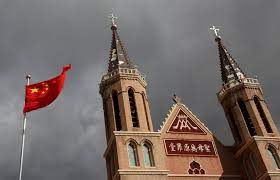The encirclement of the Catholic Church by the communist regime continues with new methods. The in-depth analysis was done by the Spanish newspaper l'Avanguardia, after the latest events and the new episcopal appointments.
In relations with the Chinese communist regime, the Holy See always walks on tiptoe on the razor's edge. The Italian Jesuit missionary Matteo ricci (1552-1610) managed, with great difficulty, to get in touch with the Chinese sensitivity to spread the Christian message. Since when Mao Zedong broke diplomatic relations with the Vatican in 1951, two years after the communist revolution, Catholicism in China has been cut in two: theCatholic Patriotic Association, obedient to the Communist Party and with government-appointed bishops, and the Catholic church loyal to the Pope, but hindered by the authorities.
It is estimated that the number of Chinese Catholics fluctuates between 6 and 12 million, adding up both communities. A glimmer of hope was the bilateral agreement signed in 2018 and renewed twice, in 2020 and in October of this year for the consensual appointment of bishops.
The balance worked until an episode at the end of November shuffled the cards with the appointment of 56-year-old John Peng Weizhao as auxiliary bishop of Jiangxi, a Chinese diocese not recognized by the Holy See. This prompted an unusually harsh statement from Rome. "This fact did not happen with the spirit of dialogue existing between the Vatican and the Chinese side, nor with what was stipulated in the provisional agreement on the appointment of bishops of 22 September 2018", says the Vatican text, which also speaks of "surprise" and "regret" for China's unilateral decision.
John Peng Weizhao, a priest since 1989, received episcopal ordination in April 2014 in secret, by order of Pope Francis, as titular bishop of the historic diocese of Yujiang. He was jailed within a few weeks and released six months later. His predecessor had spent 23 years in prison. Now, Peng has become auxiliary of a non-canonical diocese, Jiangxi - this is the name of the
Chinese province – “after long and heavy pressure from the local authorities”, says the Holy See.
Upon taking office in Nanchang, the provincial capital, John Peng Weizhao promised to “adhere to the principle of independent and self-governing churches" and of "actively guide Catholicism to adapt to socialist society”.
Since Xi Jinping became president of China in 2013, the timid openness to religion of the immediately preceding years has begun to wane. Xi wants a sinicization of religions understood as maximum adaptation to the guidelines of the communist authority and refusal of any foreign involvement. It is therefore unacceptable, in his opinion, for another country - the Vatican - to control the bishops in Chinese territory.
The news agency AsiaNews of the Pontifical Institute for Foreign Missions (PIME), precious source of information on the Catholic Church in Asia, clarifies the meaning of the operation.
Monsignor Peng Weizhao becomes auxiliary bishop of the diocese of Jiangxi
The appointment is important, since the diocese assigned to him by Francis was Yujiang, an ecclesiastical district that had existed since 1885 and where Lazarist missionaries had exercised their ministry before the communist revolution. It is therefore the Chinese authorities, without any agreement with the Holy See, who have decided to unite the five ecclesiastical districts traditionally linked to the metropolis of Nanchang into a single diocese”, explains AsiaNews.
The titular of the new diocese, John Baptist Li Suguang, is a patriotic bishop and Peng will be his auxiliary, a way to absorb the clergy loyal to the Pope. The clash with the Holy See is therefore open and will reserve many surprises.
